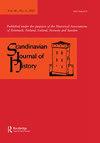“酒精是人类的敌人!”宣传海报和1922年瑞典禁酒令公投
IF 0.8
3区 历史学
Q1 HISTORY
引用次数: 2
摘要
摘要二十世纪初,瑞典围绕控制饮酒展开了激烈的公众辩论。在日益增长的禁酒运动的巨大压力下,瑞典政府于1922年8月27日通过了一项动议,举行全民公投,以确定是否应该实施全面禁酒。影响公众舆论的最重要手段之一是宣传海报,它依靠简单的图片、朗朗上口的口号和鲜艳的颜色来将禁令辩论本土化,并使其易于理解。本文对公投前“赞成”和“反对”运动制作的海报进行了研究。调查发现,尽管双方的论点相反,但双方都使用了基于家庭生活崩溃和瑞典社会崩溃的类似论点,描绘了瑞典无法无天、传统价值观受到威胁的想象中的现在或未来。此外,双方都挑起了阶级战争,在瑞典人民和政府之间制造了冲突,并将酗酒描述为一个以男性为主的工人阶级问题。总的来说,它认为“反对”的竞选海报最终更成功,因为它们能够利用选民的情绪,而不是使用理性的论据。本文章由计算机程序翻译,如有差异,请以英文原文为准。
”Alcohol is Humanity’s enemy!” Propaganda Posters and the 1922 Swedish Prohibition Referendum
ABSTRACT In the early twentieth century, intense public debate was taking place in Sweden around the control of alcohol consumption. Under intense pressure from the growing temperance movement, the Swedish government passed a motion to hold a referendum on 27 August 1922 to determine whether a total prohibition of alcohol should be implemented. One of the most important means of influencing public opinions was the propaganda poster, which relied on simple pictures, catchy slogans and bright colours to domesticate the prohibition debate and make it easily digestible. This paper conducts a study of the posters produced by the ‘yes’ and ‘no’ campaigns during the lead-up to the referendum. It finds that, despite their opposing arguments, both sides used similar arguments based around the breakdown of family life and the breakdown of Swedish society, depicting an imagined present or future in which Sweden was lawless and traditional values were threatened. Furthermore, both sides stirred up class warfare, creating conflict between the Swedish people and the government, and depicting alcoholism as a predominantly male, working-class problem. Overall, it argues that the ‘no’ campaign posters were ultimately more successful because of their ability to play on voters’ emotions rather than use rational arguments.
求助全文
通过发布文献求助,成功后即可免费获取论文全文。
去求助
来源期刊

SCANDINAVIAN JOURNAL OF HISTORY
HISTORY-
CiteScore
1.10
自引率
20.00%
发文量
33
期刊介绍:
Scandinavian Journal of History presents articles on Scandinavian history and review essays surveying themes in recent Scandinavian historical research. It concentrates on perspectives of national historical particularities and important long-term and short-term developments. The editorial policy gives particular priority to Scandinavian topics and to efforts of placing Scandinavian developments into a larger context. Studies explicitly comparing Scandinavian processes and phenomena to those in other parts of the world are therefore regarded as particularly important. In addition to publishing articles and review essays, the journal includes short book reviews. Review essay proposals and polemical communications are welcomed.
 求助内容:
求助内容: 应助结果提醒方式:
应助结果提醒方式:


